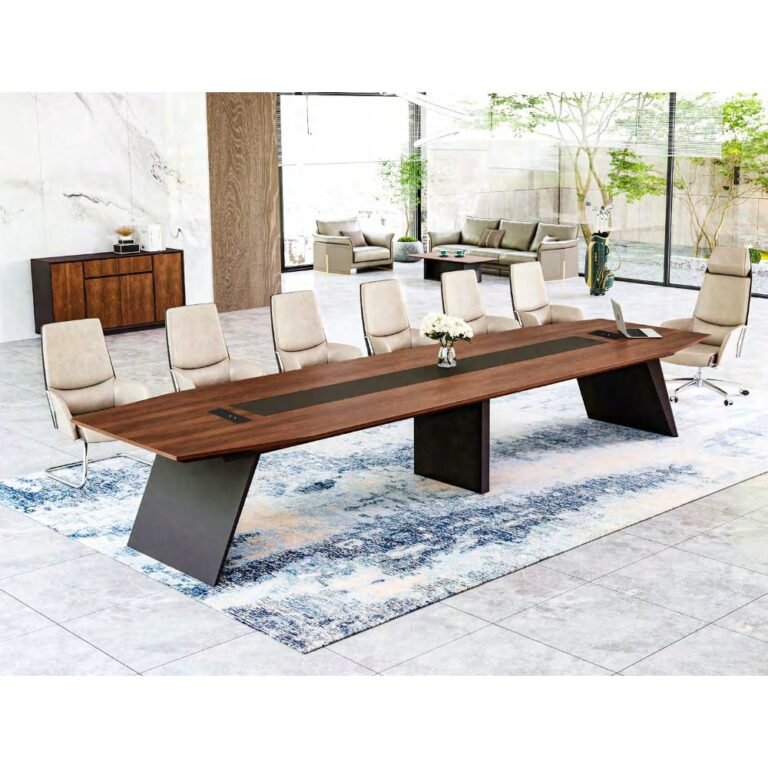As hybrid work models become the norm and health-conscious office solutions gain momentum, the 2025 China International Furniture Fair (CIFF) in Guangzhou—hosting 1,090 global exhibitors across 240,000㎡—unveiled a transformative era for office seating. This blog explores how innovation in smart health technology, sustainable materials, and modular design is reshaping the industry, offering actionable insights for businesses and buyers seeking cutting-edge solutions.
1. New Product Frontiers: Tech-Driven Innovation for Modern Workscapes
a. Smart Interactive Seating: From Furniture to Health Companions
- Yongyi Magic Comfy with Leg RestEquipped with the world’s first Magic Hinge Technology, this chair features 14 precision hinges for silent, smooth leg rest adjustment (60kg load capacity). The 7th-generation adaptive chassis auto-calibrates backrest tension based on user weight, delivering dynamic lumbar support for “perfect human-chair harmony.”
- Novus Seda SeriesIts bionic “Soft Joint Passive Lumbar Support” mimics spinal curves, reducing lumbar pressure by 30% during 2-hour sits via high-tech mesh fabric—ideal for millennial desk workers battling posture issues.
- Xihao C300i Modular Smart ChairA 7,000RPM dual-motor system simulates 5 massage modes, while aerospace-grade PI graphene heating reaches 50℃ in 87 seconds, emitting far-infrared rays to improve blood circulation—addressing cold-weather discomfort for female users.
b. Acoustic Privacy Solutions: Quiet Havens in Open Offices
- Novus Nobius 3.0 Soundproof Phone BoothAchieving Class A sound insulation with a dome skylight design, it balances visual openness and acoustic privacy—perfect for hybrid work calls and confidential meetings.
- Aurora Angle K SofaSound-absorbing fabric and modular design create flexible meeting nooks, reducing ambient noise by 25dB to boost collaborative efficiency.
c. Sustainable Materials: Bamboo Fiber & Recycled Plastics Take Center Stage
- Bamboo Fiber FrameworksDriven by China’s “Bamboo for Plastic” policy, Guizhou Chishui’s bamboo industry project introduces chair frames 20% stronger than wood, with a 70% shorter production cycle—cost-effective and eco-friendly.
- Ocean-Conserved PlasticsRecycled marine plastics craft chair wheels and armrests, achieving over 85% material circularity, aligning with the EU’s 95% recycling target by 2026.
2. Emerging Trends: Health, Sustainability & Digital Integration
a. Health-Centric Design: Proactive Wellness Over Passive Support
- Real-Time Health MonitoringIntegrated heart rate and SpO2 sensors sync with apps to track user health data, reducing lumbar disease risks by 40% via intelligent sedentary alerts.
- Customized Fit Technology3D body scanning generates personalized support plans, adapting to users from 155cm to 190cm—ending the “one-size-fits-all” compromise.
b. Sustainability as a Business Imperative
- Policy-Driven InnovationChina’s Three-Year Action Plan for “Bamboo Substitution” aims to increase bamboo product value by 20% by 2025, driving a 15% cost reduction for bamboo fiber chairs compared to plastic alternatives.
- Circular Economy Models“Lease & Recycle” programs ensure 90% of metal and plastic components are reused, slashing lifecycle carbon footprints.
c. Digital & Modular Flexibility
- Smart ConnectivityChairs integrate with smart home systems, allowing voice-controlled adjustments for height and temperature—boosting workflow efficiency.
- Future-Proof ModularityXihao C300i’s upgradeable lumbar pillow lets users add massage or heating functions without replacing the entire chair, cutting upgrade costs by 30%.
3. Market Dynamics: Competition, Growth & Consumer Shifts
a. Market Expansion & E-Commerce Rise
- China’s office furniture market hits 250 billion RMB in 2025, with seating accounting for 30% of sales. Online channels now capture 45% of purchases, as Gen Z buyers favor tech-driven, direct-to-consumer brands.
b. Brand Landscape: Global Titans vs. Local Disruptors
- Premium Segment: Steelcase and Herman Miller dominate >5,000 RMB markets with 60% share, leveraging ergonomic patents.
- Mid-Market Innovators: Yongyi and Xihao gain ground with affordability (Xihao C300i priced at 2,699 RMB, 30–70% lower than competitors), making smart tech accessible.
c. Supply Chain Adaptation
- Cost Challenges: A 12% steel price surge drives adoption of aluminum-magnesium alloys and bamboo to cut costs.
- Smart Manufacturing: Homag China’s automated production lines triple daily output while reducing labor costs by 70%, ensuring scale without compromise.
4. Future Outlook: Tech-Ecology Synergy
a. AI & Biotech: The Next Frontier
- AI-Powered Personalization: Algorithms will auto-optimize chair settings based on user behavior, creating “1,000 chairs for 1,000 users.”
- Bio-Material Revolution: Mycelium and seaweed fibers could replace 40% of traditional plastics by 2030, marking a leap in sustainable design.
b. Expanded Scenarios: Home & Public Spaces
- Work-From-Home Demand: Foldable chairs and multi-function recliners for small spaces see a 25% growth forecast in 2025.
- Vertical Market Penetration: Healthcare and education sectors drive demand for adjustable, antibacterial seating, opening new B2B opportunities.
c. Regulatory Tailwinds
- Global Standards: The EU’s New Battery Regulation (95% recycling by 2026) and China’s “Office Health Certification” (with tax incentives) accelerate compliance and quality upgrades.
Why This Matters for Your Business
The 2025 CIFF signals a pivotal shift: office seating is no longer a utility but a strategic investment in employee well-being, brand sustainability, and future-readiness. By prioritizing products that blend smart health technology, circular materials, and modular adaptability, businesses can:
- Attract hybrid work teams seeking comfort and productivity.
- Meet ESG goals with transparent, eco-friendly supply chains.
- Future-proof budgets with durable, upgradeable solutions.
Explore Our 2025 Collection to discover chairs that align with today’s trends—where innovation meets intention. Contact us to discuss customized solutions for your workspace!


